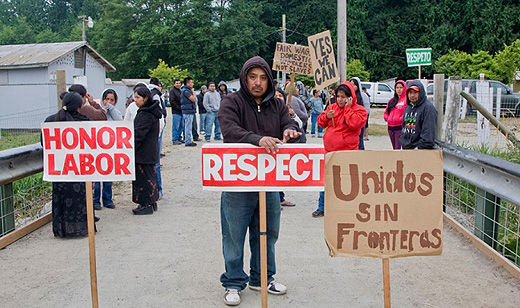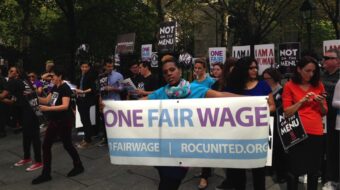
BURLINGTON, Wash. – Filemon Pineda traveled a thousand miles to northwest Washington to pick strawberries and blueberries, as he’s done for three years. He left Santa Maria, California, in April, got picking jobs for himself and his wife at Sakuma Brothers Farms, one of the state’s largest berry growers, and was assigned a dilapidated cabin in Labor Camp 2.
He bought a cheap bunk bed, and the company gave him some ancient mattresses, one even wrapped in an old black plastic sheet. His three small children slept together on one bunk, while he spread the other mattresses on the concrete floor, which he covered with carpet samples.
When he went to work, though, he found he wasn’t making enough to survive the coming winter, once the family returned to California. He and his coworkers in Camp 2 stewed over their problems for several months. Finally, in July, they’d had enough. When the blueberry picking started, the company fired Federico Lopez on July 10 for asking for a wage raise, and workers went on strike on July 11 to get his job back.
They organized a committee, Families United for Justice, and later formulated a list of demands that included wage raises and improvements in conditions in the labor camp where they lived. Sakuma Brothers Farms has two labor camps – temporary housing for migrant workers during the picking. Over 200 families live in Camp 2.
Lopez was rehired on July 15, and workers returned to their picking jobs while they continued to negotiate with the company. On July 20 they struck again, accusing the company of lowering their piece rate wage. On July 26 they went back to work, while continuing to talk about wage increases. Company picking records showed that 248 workers had participated in the strike – the vast majority of the 278 working at the time.
In the course of these negotiations, however, the workers discovered the limit to any improvements they could expect. Sakuma Brothers Farms had made an application with the Department of Labor for 160 H2A guest workers in April, which a labor contractor would hire in Mexico, and bring to the farm in August to pick late blueberries and blackberries.
“They negotiated with us, which was a big achievement,” explains Rosalinda Guillen, director of Community2Community. The farm worker advocacy and organizing project she heads in northwest Washington was the workers’ key source of support.
Guillen concluded, however, that the main reason the company negotiated was fear that their application for H2A workers would be suspended because of the strike. Federal regulations prohibit employing H2A workers if a labor dispute exists at the employer. According to Nina Martinez of the Latino Civic Alliance, a group of Washington state Latino political activists, the Department of Labor only lifted a suspension on Sakuma’s application when workers returned to work on July 26. “That’s why Sakuma negotiated,” Guillen believes. “They had to end the labor dispute.”
The H2A program was established in 1986, to allow U.S. agricultural employers to hire workers in other countries, and bring them to the U.S. In this program, the company first must certify that it has tried to hire workers locally. If it can’t find workers at the wage set by the state employment department, and the department agrees that the company has offered the jobs, the grower can then hire workers outside the country. The U.S. government provides visas that allow them to work only for this employer, and only for a set period of time, less than a year. Afterwards, they must return to their home country. If they’re fired or lose their job before the contract is over, they must leave right away. Growers must apply for the program each year.
In the past, Sakuma Farms relied on local workers and migrants from California, like Pineda’s family, to fill its 7-800 picking jobs at the peak of the harvest during the summer. This is the first year the company has applied to bring in H2A workers.
The company’s use of this contract labor program supports accusations made by critics over the years — that guest worker programs hold down wages. With Congress debating vastly expanded programs like H2A, this impact could become much more widespread, and even determine the overall wage level for other workers in agriculture and industries heavily dependent on immigrants. According to a report by Farmworker Justice, a farm labor advocacy group in Washington D.C., “Guest worker programs drive down wages and working conditions of U.S. workers and deprive foreign workers of economic bargaining power.”
Strikers were motivated as much by discrimination as they were over wages. Most strikers come from towns in Oaxaca and southern Mexico where people speak Mixteco and Triqui, indigenous languages that predate the Spanish colonization. Bernardo Ramirez, who heads an organization of indigenous Mexicans, the Binational Front of Indigenous Organizations, traveled from Oaxaca to support them. “Foremen have insulted them, shouted at them and called them ‘burros [donkeys],'” he charged. “When you compare people to animals, this is racism. We’re human beings. Low wages are a form of racism too, because they minimize the work of indigenous migrants.”
With the blueberries in danger of getting overripe before the guest workers arrived, the company sat down and talked. In addition to rehiring Federico Lopez, the Sakumas discussed other problems, and resolved some, like replacing the ancient mattresses in the camp. But when it came to wages, “the H2A rate limits what’s possible,” Guillen says. “The workers asked for $14/hour but had to accept $12 because that’s what the workers who were coming would get.” The company pays a piece rate, and guarantees that workers will earn at least the hourly wage. Workers were demanding an improvement in both – a $14 hourly guarantee, and a minimum price of $6 a box. The company would not pay more than $4 a box, and a $12 per hour guarantee, saying that the higher demand would raise its labor costs too much.
When workers work at a piece rate, they earn according to the number of boxes they pick. If the field is bad or they don’t pick fast enough, a guaranteed rate ensures that they still make a set minimum per hour. They also wanted a higher piece rate – $6 instead of $4 per box. People who pick quickly would earn a lot more.
Twelve dollars sounds like a lot for farm labor, which often pays close to minimum wage. But workers have only a few months to earn enough to support large families through the winter, when work is scarce and they have to live off their savings. According to one striker who’s worked at Sakuma Brothers Farms for five years, Lucia Martinez, “by December our money has run out, and we have to get loans to survive.”
Photo: Workers protest at Sakuma Brothers Farms. Binational Front of Indigenous Organizations
This article was edited for length. The full article appears here on Al Jazeera America.












Comments